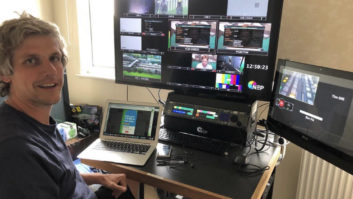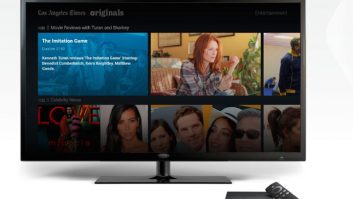
Over the last couple of years the name KIT Digital has come to the fore, arising seemingly from nowhere to become a major player, and making high profile acquisitions of companies as diverse as Ioko and systems integrator Megahertz Broadcast Systems. So who are they and what is their big plan? Dick Hobbs investigates.
KIT Digital’s Chief Operating Officer Alex Blum (pictured) says his background is in internet video, first with AOL then with JumpTV, a pioneering service provider. It aimed to deliver international content online so that, for example, a Romanian ex-pat in the USA could watch his national sports competitions.
It was at JumpTV that he first worked with Kaleil Isaza Tuzman, now CEO of KIT Digital. At JumpTV Tuzman was the face of the company, travelling the world signing up broadcasters to provide the content for the online service.
“This was very early in the online social video business,” Blum explains. “We had to build our own backhaul network, our own CDN. And we built a playback experience, which was like today’s social TV.
“We knew that all broadcasters need to be network operators – they are fed up with carriage deals,” he adds. “They did not have the ability to launch a cable or satellite network, so they signed up with JumpTV as a first step: we enabled a whole new class of network operators.”
Those early experiences at JumpTV sparked initial ideas that would later become the origins of KIT Digital. Tuzman realised that if they white-labelled the service they could sell it to individual broadcasters and content owners, to enable them to deliver over IP. “The technology was converging, through a higher broadband penetration and network improvements,” says Blum, “so IP delivery could be of broadcast quality.”
According to Blum, Tuzman saw that a window of opportunity was opening very rapidly for a new type of content distribution system. He recognised that he needed to bring all the pieces together into the new company, which meant adding capabilities by acquisition. If the strategy behind the acquisitions did not seem very clear at the time, this was a deliberate decision!
“We believe that the migration to broadband delivered television is inevitable,” Blum remarks. “To achieve this it needs more than just the software, more than the technology, more than best in class systems integration. It needs modern, scalable, cloud technology, which can deliver a more engaging experience than broadcast television alone.
“Today video consumption is overwhelmingly over legacy delivery platforms,” he adds. “IP may be under 10%. In the next few years it will be 35 or 40%.”
Engaging consumers
The essence of the KIT Digital vision of the future is that this is social television, a rich experience building on the routine multi-screening audiences are already doing. “There is a misconception in the industry about this,” Blum claims. “It is not just a mash-up of television and the internet. It has to be a new experience, using synchronised behaviours across the screens for a richer, interactive, social element.”
What does that mean for broadcasters? What does it mean for the traditional vendors who are developing strong solutions for multi-screen services? As you would expect of the COO of a company which believes it has stolen a lead on the rest of the industry, Blum points to KIT Digital as the source of a single, well integrated end-to-end solution.
“There are systems integrators developing big, multi-platform systems, but they are major implementations,” he says. “We too have major deployments but have brought this down from years and hundreds of millions of dollars to implement to months and millions of dollars.
“The end game is around the direct relationship with the consumer,” he says. “Who owns that relationship is best placed to succeed. We enable any party to do it, from broadcasters and content owners looking to disintermediate traditional operators, to non-media enterprises looking to engage consumers with video.”
So, I asked, does this mean that the traditional broadcaster and network operator is under threat? “If they do not accept this new idea, then they are in big trouble,” is Blum’s uncompromising view. “The IP-delivered video experience is everything.”
The KIT Digital solution appears to put content creators and broadcasters into conflict: if the content creator earns a direct relationship with the consumer, then is there a need for the broadcaster? How can the company reconcile this conflict?
“We are trying to be Switzerland,” he says. “Network operators need help to change; broadcasters and content owners, in different ways, need to open up new services. We can help them both.”
Percentage points
Returning to the question of quality, digital broadcasting over terrestrial, cable and satellite now delivers good quality HD to large audiences. This has met the developed expectations of consumers looking for content, which uses the new generation of flat panel displays to best effect.
Conversely, consumer expectations of internet video are low: limited resolution, long buffering times and stuttering playback. The infrastructure of the internet, too, must represent a challenge, as it is designed to transport relatively small files from point to point, not long video broadcasts from point to multi-point. Will network capacity be a limiting factor?
Blum acknowledges that this is a challenge, and tells me that it has been a major focus of its development. He believes they have developed an architecture to deliver a broadcast grade experience. Pressed on that, he does concede that, at present, the experience might not match the current technical audio and video levels of broadcast systems.
“However at present consumers are happy with the quality of the image, the interactivity and the targeted content that they receive,” he says. He compares it with the massive popularity of mobile phones, which are very good but not as reliable as landlines. “Consumers are prepared to lose the last few percentage points in performance, provided the other advantages are there. We are moving to the point where we can enable operators to provide the experience which consumers will enjoy.”
KIT Digital has taken its aggressive approach to acquisitions specifically to achieve this new end-to-end platform, but it sees skills across the group providing cross-fertilisation into other areas.
Megahertz, for example, and sister company Benchmark which is a Far East systems integrator, benefit from increased capabilities in IP infrastructures, because all broadcast production platforms will be moving that way. But at the same time, the extensive knowledge of traditional broadcast hardware feeds the other way, helping the software teams develop new tools and applications.
In the spring of 2011, KIT Digital further strengthened its European presence with the acquisitions of Milan-based Polymedia and UK-based ioko. Responsible for powering many of the most advanced broadcast and network operator video deployments across Europe, these companies have enhanced KIT’s capabilities to deliver multi-screen OTT solutions and provide managed and secure cloud platform infrastructures.
“Everyone in the industry is aware that social media is transforming the way consumers interact with television: it is one of the major topics in the IBC conference this year,” he says. “What we are delivering today is a platform that empowers any organisation to produce and deliver an integrated, engaging service.”







